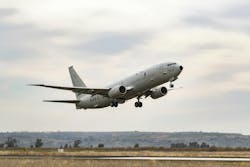Navy asks BAE Systems to provide electronic warfare (EW) missile-defense aircraft survivability pod for P-8A
PATUXENT RIVER NAS, Md. – Electronic warfare (EW) experts at BAE Systems will build three electronic pods to help protect large aircraft such as the P-8A Poseidon maritime patrol and surveillance aircraft from radar-guided missiles and electronic jamming under terms of a $40.7 million order announced last week.
Officials of the Naval Air Systems Command at Patuxent River Naval Air Station, Md., are asking the BAE Systems Electronic Systems segment in Nashua, N.H., for three low-rate initial production Advanced Survivability Pods for the P-8A aircraft.
The missile-defense pod helps P-8A crews detect and counter electromagnetic spectrum threats such as radar-guided missiles and EW jamming at extended ranges, BAE officials say. It helps the P-8A counter enemy guided missiles, sensors, radar, and surveillance systems.
The BAE Systems Advanced Survivability Pod is for so-called high-value aircraft like the P-8A; the C-130 and C-17 cargo planes; and KC-135 and KC-46 aerial tankers, and to help these aircraft operate closely to enemy airspace.
Multi-spectral threats
The portable EW pod delivers multi-spectral threat detection, countermeasures, and route planning to improve aircraft survivability; sensor fusion for situational awareness; long-range threat warning; RF countermeasures; portability; dynamic route planning and tactics; and readiness for emerging threats.
The Advanced Survivability Pod mounts to the P-8A pylon to create a protective shield around the aircraft to detect threats from above and below.
The pylon pod includes high-performance RF antennas; small-form-factor RF jammer; high-power RF amplifier; fiber-optic towed decoy; and infrared threat-detection sensors. Its open-architecture design is compatible with future threat-detection and decoy countermeasures, and can host third-party EW techniques.
On this order BAE Systems will do the work in Nashua, N.H.; Austin, Texas; and Patuxent River Naval Air Station, Md., and should be finished by January 2030. For more information contact BAE Systems Electronic Systems online at www.baesystems.com/en-us/our-company/inc-businesses/electronic-systems, or Naval Air Systems Command at www.navair.navy.mil.
About the Author
John Keller
Editor-in-Chief
John Keller is the Editor-in-Chief, Military & Aerospace Electronics Magazine--provides extensive coverage and analysis of enabling electronics and optoelectronic technologies in military, space and commercial aviation applications. John has been a member of the Military & Aerospace Electronics staff since 1989 and chief editor since 1995.
